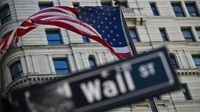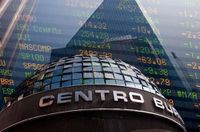On Wednesday, April 9, 2025, Asian stock markets predominantly traded lower, and U.S. stock futures plummeted following the enforcement of President Donald Trump's massive 'reciprocal' tariffs. These tariffs, the largest imposed by the United States in a century, impose widespread import taxes, some as high as 50%, on dozens of countries. The fear has gripped investors worldwide as these tariffs threaten to plunge both the global and U.S. economies into recession this year.
As a direct consequence of these tariffs, the Nikkei index in Japan plunged by 4%, while the Hang Seng index in Hong Kong fell 1.5% after a brief respite the previous day. On Monday, April 7, 2025, the Hang Seng had experienced a staggering 13% drop, marking its largest daily decline since the Asian financial crisis of 1997. Meanwhile, the Kospi benchmark index of South Korea headed toward a downward trend, suffering a 20% drop from its recent high after the country announced $1.3 billion in emergency support measures for its automotive industry to mitigate the tariffs' impact.
Markets in Taiwan also faced drastic declines on April 9, 2025. However, the Shanghai Stock Exchange recorded a slight gain, a rare occurrence amid a sea of losses. U.S. stock futures fell considerably after a volatile Tuesday, April 8, 2025, which had initially shown signs of recovery. White House Press Secretary Karoline Leavitt stated that China had missed the deadline to lift a 34% retaliatory tariff imposed on U.S. products, prompting the Trump administration to nearly double its additional tariff on China. As of Wednesday morning, all Chinese products entering the United States will face a minimum tariff of 104%.
Many other nations that avoided the so-called reciprocal tariffs still face a universal tariff of 10% that the Trump administration imposed on April 5, 2025. The Dow Jones futures fell by 750 points, or 2%, while S&P 500 futures dipped 2.2% and Nasdaq futures dropped 2.5%. The S&P 500 was preparing to open in bear territory, signaling a rapid drop of 20% from the index's all-time high reached just seven weeks prior on February 19, 2025. If the U.S. stock market closes in a bearish scenario, it will mark the end of a bullish streak that has persisted since the peak of the inflation crisis in mid-October 2022, representing the second-fastest decline from a record high to a bear market in the S&P 500's seven-decade history. Only the COVID-19 pandemic saw stocks plunge into a bear market at a quicker pace.
In the midst of this turmoil, U.S. oil prices plunged over 4% below $57, reaching their lowest level since February 2021, while benchmark Brent crude fell close to $60 per barrel. The declining oil prices are attributed to fears that a global recession could undermine demand for travel, transport, and shipping, all of which require fuel. Conversely, investors have flocked to traditional safe-haven assets like gold, which rose more than 1%, nearing an all-time high. Interestingly, the benchmark 10-year yield, which had fallen below 4% earlier in the week, surged back above 4.3%. Normally, during crises, investors seek long-term bonds, hoping that short-term market issues will resolve over time. However, the bond market, like the stock market, has also faced extreme volatility in recent days, prompting some investors to seek exits.
On Tuesday, April 8, 2025, the Mexican Stock Exchange (BMV) reported a loss of 0.28% in its main indicator, the IPC, which fell to 50,316.59 units. Gabriela Siller, the director of Economic and Financial Analysis, noted that the market closed with mixed results amid global indices, with the anxiety surrounding the escalation of the trade war contributing to losses in U.S. indices. "The market closed with mixed results among the main global stock indices. In the United States, strong gains were observed at the start of the session," Siller commented.
Despite the overall downturn, there was a momentary recovery in global stock indices on April 8, 2025, after several days of historic declines. The three major Wall Street indices opened with gains nearing 4%, following the lead of European stocks, which advanced between 2% and 3% at the close, and Asian stocks that rebounded by up to 6% in Tokyo. This uptick came after three days of significant losses that had wiped trillions of dollars off stock values due to the impact of Trump’s tariffs on the economy.
Japan and South Korea appeared closer to dialogue with the United States, with Trump placing Secretary of the Treasury Scott Bessent and trade representative Jamieson Greer in charge of negotiations with both countries. The European Commission also announced a 'zero for zero' tariff agreement to avoid a trade war with the United States while countering with a proposal for 25% tariffs on some U.S. imports. Meanwhile, China has shown less willingness to concede ground, with officials labeling the U.S. stance as a form of "blackmail" and promising to "fight to the end" against potential tariff increases.
As the situation develops, Wall Street remains cautiously optimistic for negotiations, which helped spur the morning rally on April 8, 2025. Trump indicated that discussions with South Korea's acting president have led to the potential for a significant agreement beneficial to both nations. He stated, "Their main team is on a plane to the United States, and things look good." Despite the temporary relief in the markets, analysts warn that the underlying fundamentals causing the market drops have not changed, indicating that volatility may persist in the days and weeks ahead.







